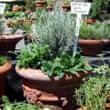Background
- Since ancient Egypt, white horehound (Marrubium vulgare L.) has been used as an expectorant (to facilitate removal of mucus from the lungs or throat). Ayurvedic, Native American, and Australian Aboriginal medicines have traditionally used white horehound to treat respiratory (lung) conditions. The U.S. Food and Drug Administration (FDA) banned horehound from cough drops in 1989 due to insufficient evidence supporting its efficacy. However, horehound is currently widely used in Europe, and it can be found in European-made herbal cough remedies sold in the United States (for example, Ricola®).
- There is a lack of well-defined clinical evidence to support any therapeutic use of white horehound. The expert German panel, the Commission E, has approved white horehound for lack of appetite, dyspepsia (heartburn), and as a choleretic. There is promising early evidence favoring the use of white horehound as a hypoglycemic agent for diabetes mellitus and as a non-opioid pain reliever.
- There is limited evidence on the safety or toxicity in humans. White horehound has been reported to cause hypotension (low blood pressure), hypoglycemia (low blood sugar), and arrhythmias (abnormal heart rhythms) in animal studies
References
- El Bardai S, Morel N, Wibo M, et al. The vasorelaxant activity of marrubenol and marrubiin from Marrubium vulgare. Planta Med 2003;69(1):75-77.
View Abstract - Herrera-Arellano A, Aguilar-Santamaria L, Garcia-Hernandez B, et al. Clinical trial of Cecropia obtusifolia and Marrubium vulgare leaf extracts on blood glucose and serum lipids in type 2 diabetics. J Phytomedicine 2004 Nov;11(7-8):561-6.
View Abstract - Novaes AP, Rossi C, Poffo C, et al. Preliminary evaluation of the hypoglycemic effect of some Brazilian medicinal plants. Therapie 2001 Jul-Aug;56(4):427-30.
View Abstract - Roman RR, Alarcon-Aguilar F, Lara-Lemus A, et al. Hypoglycemic effect of plants used in Mexico as antidiabetics. Arch Med Res 1992;23(1):59-64.
- Saleh MM, Glombitza KW. Volatile oil of Marrubium vulgare and its anti-schistosomal activity. Planta Med 1989;55:105.
- Schlemper V, Ribas A, Nicolau M, et al. Antispasmodic effects of hydroalcoholic extract of Marrubium vulgare on isolated tissues. Phytomed 1996;3(2):211-216.
- VanderJagt TJ, Ghattas R, VanderJagt DJ, et al. Comparison of the total antioxidant content of 30 widely used medicinal plants of New Mexico. Life Sci 2002 Jan 18;70(9):1035-40.
View Abstract







